The Visionary CEO’s Guide to Sustainability

Executive Summary
- Wildfires, droughts, and other climate-related perils threaten banks’ loan portfolios, yet many have only a general sense of their vulnerabilities.
- We expect real estate assets’ exposure to physical risk to rise over the next couple of decades, likely reducing the value of collateral and damaging banks’ mortgage business profitability.
- Banks that take the right steps soon could improve their financial stability, customer retention, and compliance with emerging regulatory standards.
- Measuring physical risk requires new tools, capabilities, forecasting horizons, and data—all of which have been challenging to source and embed.
This article is part of Bain’s 2023 CEO Sustainability Guide
As if banks don’t have enough to worry about with high inflation and the recent turmoil around liquidity and long-term assets, now, another risk looms increasingly large—namely, the destructive power of the natural world. High winds, floods, and other hazards pose significant threats to real estate assets and more broadly to the productivity of businesses within banks’ portfolios. To better understand the risks and trends accompanying these perils, Bain & Company analyzed data provided through a unique strategic partnership with climate risk analytics firm Jupiter Intelligence.
Written in collaboration with
Written in collaboration with

Banks have begun to understand their climate risks, in part because regulators are starting to probe the vulnerabilities of portfolios’ risk through climate stress-testing. But few banks have holistically quantified their physical risks by business or industry using forward-looking data and scenario-based modeling, as opposed to historical data. Even fewer have taken steps to mitigate the risks. Given the continued housing and commercial development in harm’s way, banks need to get more rigorous about addressing climate-related physical risks.
Perfect storms
Since the middle of the last century, climate-related perils have been growing worldwide in number and intensity, the World Meteorological Organization reports, a pattern consistent with rising carbon dioxide emissions and temperatures. Human settlement and economic activity, meanwhile, continue to expand along seacoasts and other vulnerable areas.
Financial regulators globally have taken notice and increasingly ask for more accountability on physical risk measurement. The European Banking Authority, for instance, now requires banks to carry out scenario analyses on how such risks could affect the loan portfolio.
Yet banks are only now starting to incorporate physical risk into their business models. Bain analyzed the top 50 banks globally (by total assets) that currently adhere to the Financial Stability Board’s Task Force on Climate-Related Financial Disclosure. Bain found that in Europe, only 18% of those banks have begun to integrate physical risks into their business strategy.
Sizing the exposure
The data and tools available to help measure and understand the extent of various physical perils and their economic costs have become more reliable. Financial losses range from crop failure to damaged infrastructure to business and employment interruption.
Bain used Jupiter Intelligence’s data to assess the extent of physical risk exposure over a 30-year horizon in any country, down to individual properties in a neighborhood. Jupiter measures physical risk across eight perils: flood, precipitation, wind, heat, wildfire, hail, drought, and cold. Based on a score that synthesizes those perils, Jupiter assigns a risk intensity to the region.
Consider how much territory falls in the high-risk category—namely, a territory where an extreme event such as a hurricane or flood has a high probability of occurrence. As an example, Jupiter categorized 43% of the US, 63% of Australia, and 31% of Indonesia as high risk. For all countries assessed, physical risk increases over time (see Figure 1). In Germany, 33% of the territory is exposed to high physical risk today, a level expected to double by 2050. In Brazil, the extent of high-risk territory will likely triple by 2050, to 74%. In sum, physical risks are already widespread and will grow worse.
Physical risks are expected to increase in every country
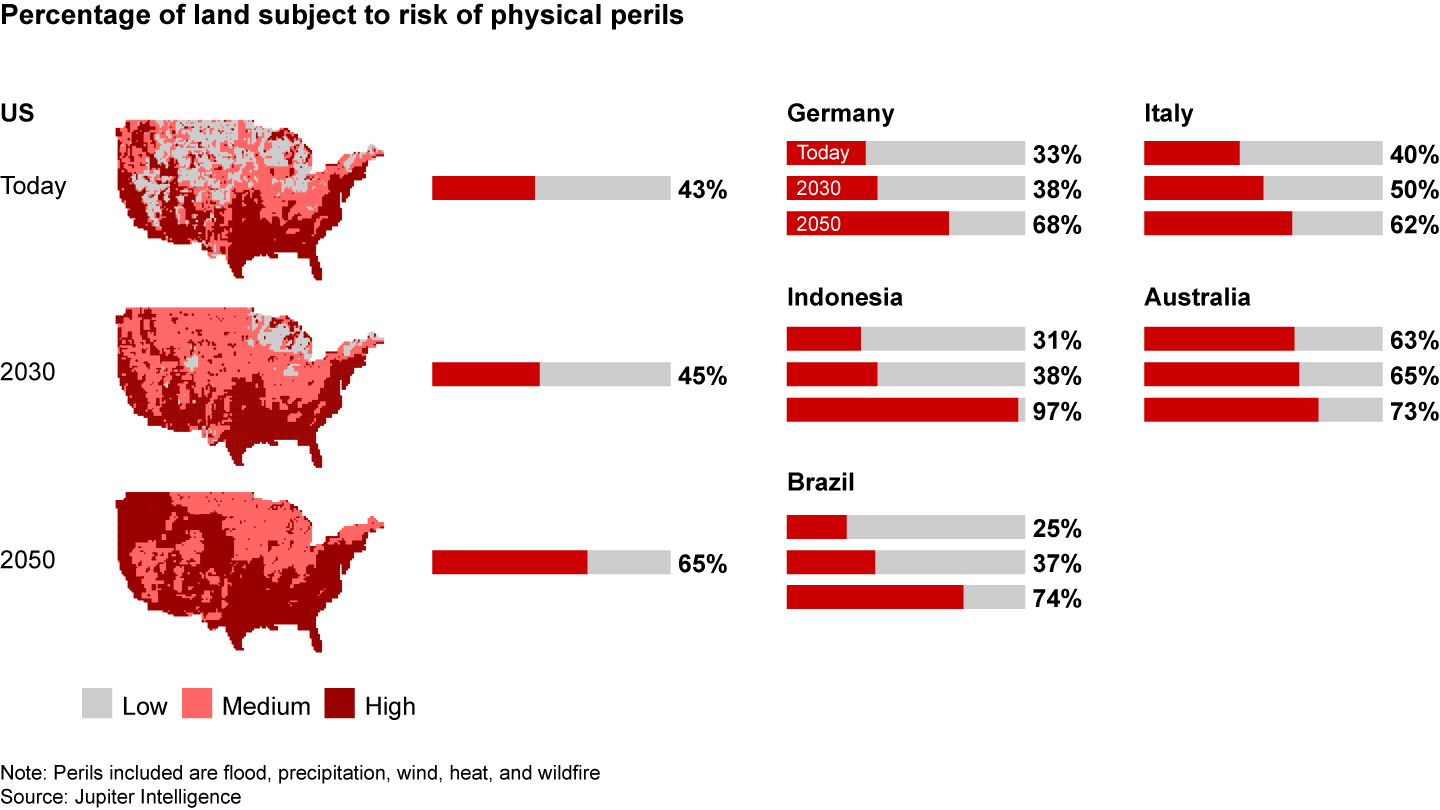
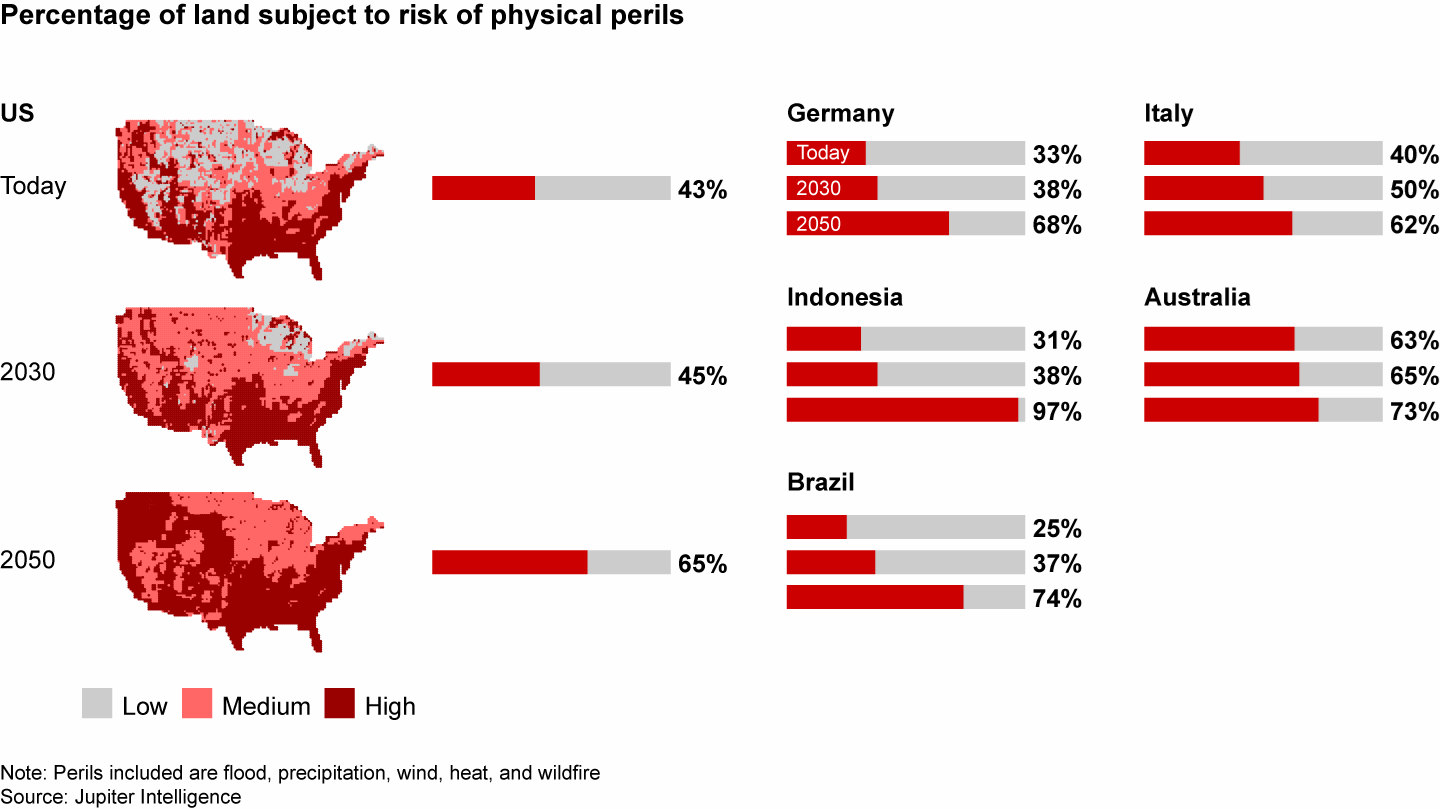
Physical risk affects banks mainly in two ways. First, it damages collateral, such as a house or factory, and reduces its value. Second, it impairs and may lead to the insolvency of counterparties because of a loss of production and creditworthiness. For example, crop failures caused by drought or flooding could expose an agribusiness to losses that make it difficult to repay a loan.
Of course, any single natural hazard will have a different degree of impact on each country or industry in a bank’s portfolio. Banks will also want to assess different outcomes of an event, whether those are physical damages, rising energy costs, or business interruptions.
Exposure of a mortgage portfolio
To illustrate the potential effects of climate events on the banking sector, Bain analyzed a sample mortgage portfolio of 10,000 assets in Italy, using Jupiter data. We assessed the current and expected future physical risk exposures for all eight perils across UN climate panel scenarios that range from carbon dioxide emissions cut severely to reach net zero after 2050 (Shared Socioeconomic Pathway 1-2.6, SSP1-2.6) to emissions that hover around current levels before starting to fall midcentury (SSP2-4.5) to emissions that roughly double by 2050 (SSP5-8.5). Across Italy as a whole, 40% of these sample locations are already highly exposed to at least one natural hazard today, a level expected to rise to 62% by 2050, which highlights the need for a comprehensive physical risk data set.
The assessment reveals how quickly a mortgage portfolio can become exposed to high levels of risk related to one hazard—in this case, fire, taking into account factors such as fuel availability and local fire suppression (see Figure 2). When the effects are combined with those of flood and drought risks on our sample portfolio, our analysis shows that damages could be as high as 10 to 15 percentage points of the value of collateral, and potentially much higher for assets in very high-risk areas.
In Italy, twice the number of assets will be exposed to high risk and three times more assets exposed to very high risk of fire by 2050
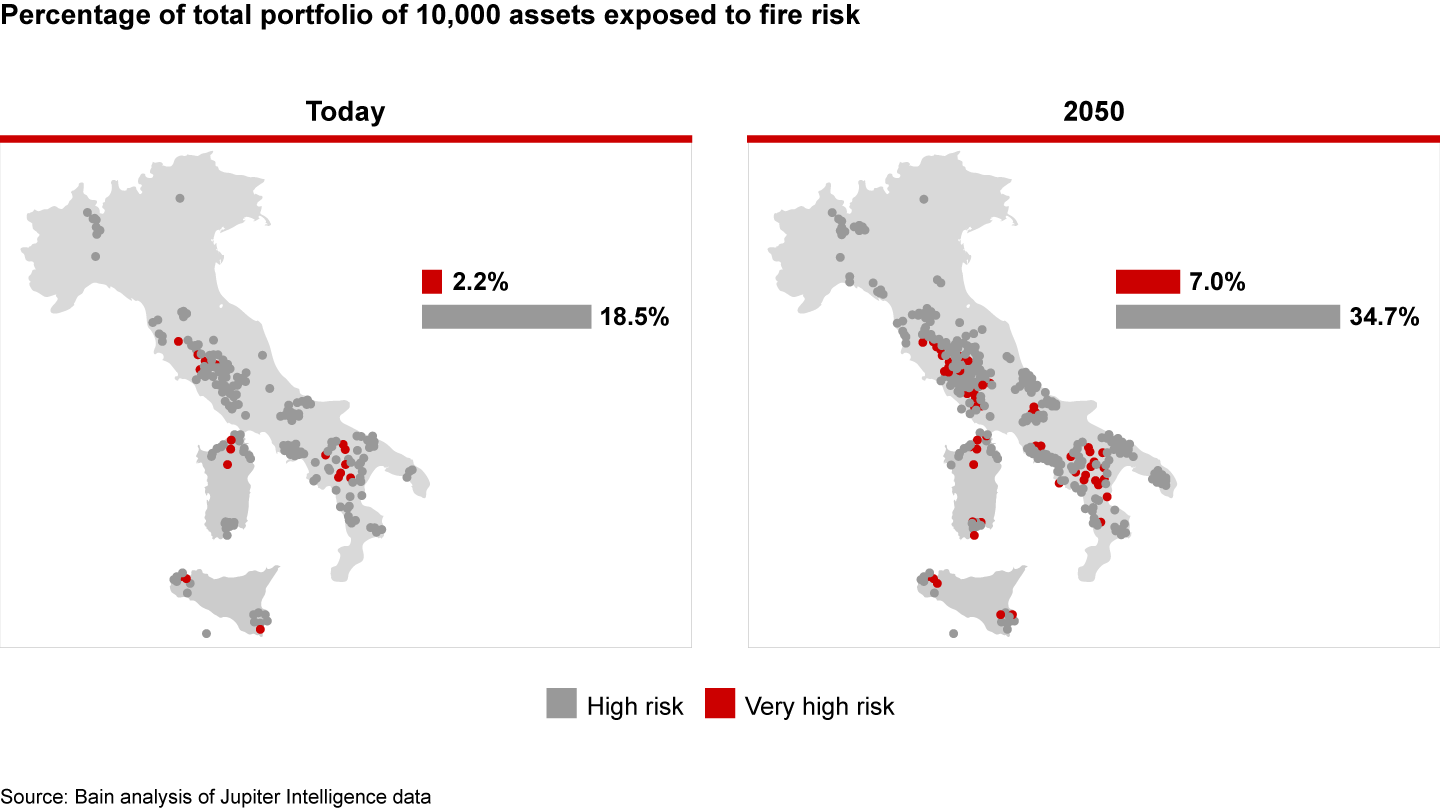
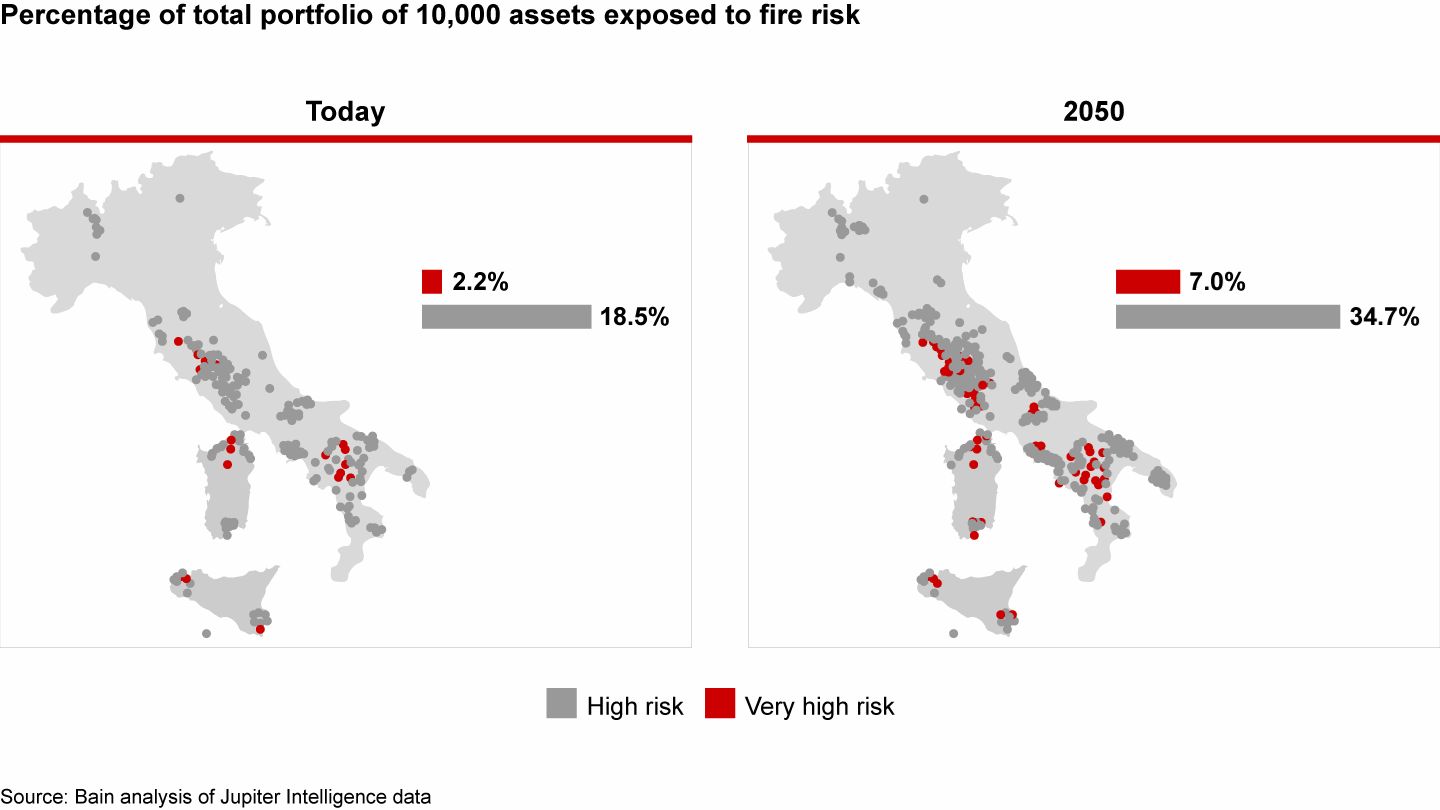
The damage could then worsen already eroded margins via a 7- to 10-percentage-point reduction in the profitability of newly originated mortgages over a 10-year period. The magnitude of this hit to profits raises the stakes for banks to clearly understand how physical risks can affect their portfolios.
Developing a sound strategy
This type of analysis is essential for developing a sound strategy that combines mitigation measures with opportunities for new business.
Defensive tactics. The analysis first informs decisions on how to mitigate risks through defensive tactics such as:
- imposing loan-to-value caps;
- shifting the mix of customer segments;
- reducing the cost of risk through credit protection insurance; and
- adjusting prices on highly exposed areas.
Defensive tactics could be worth 5.5 percentage points in net operating income to the mortgage portfolio of a bank.
Offensive tactics. Beyond the defensive stance of mitigating risks, banks can take a more offensive posture by, for instance:
- raising discount levels on low-risk assets;
- pushing for credit protection insurance; and
- standalone climate risk protection insurance.
Offensive moves could add an additional 5.3 percentage points in net operating income.
New offerings. Banks can also create a competitive advantage by developing new financing products and advising clients to help them make the transition. New risk-related business opportunities could include the following:
- fostering and financing adoption of climate adaptation solutions;
- promoting public-private partnership financing in cities and towns; and
- offering assessment of the physical risk resiliency of corporate assets and facilities.
This set of new business moves could further add 10 percentage points to net operating income.
In sum, combining mitigation measures with value creation moves could yield a 15- to 20-percentage-point (or more) increase in net operating income in 2030. Moreover, taking limited or no action will have more severe consequences over time (see Figure 3).
As physical risks increase, banks should adopt a mix of defensive and offensive tactics while also pursuing new business opportunities
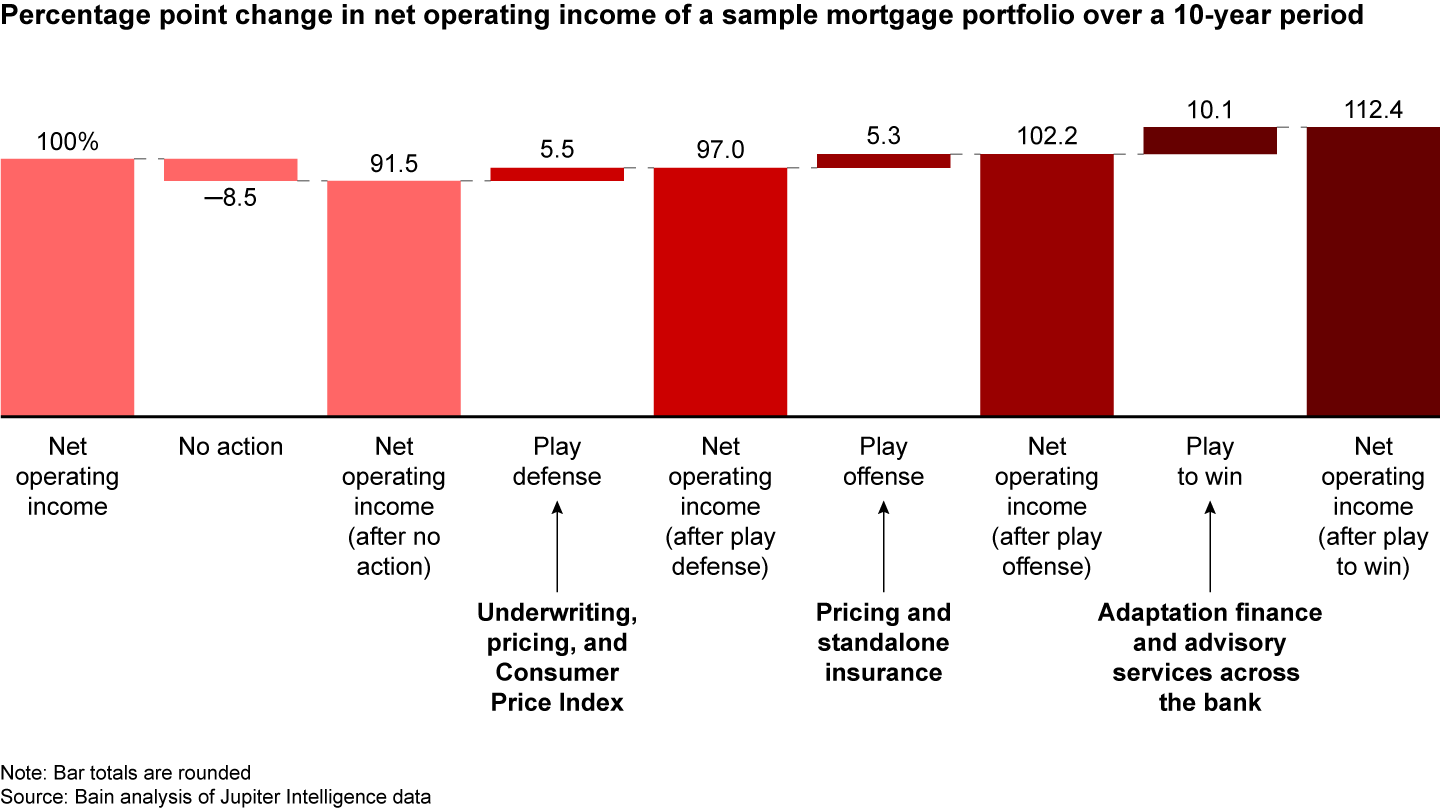
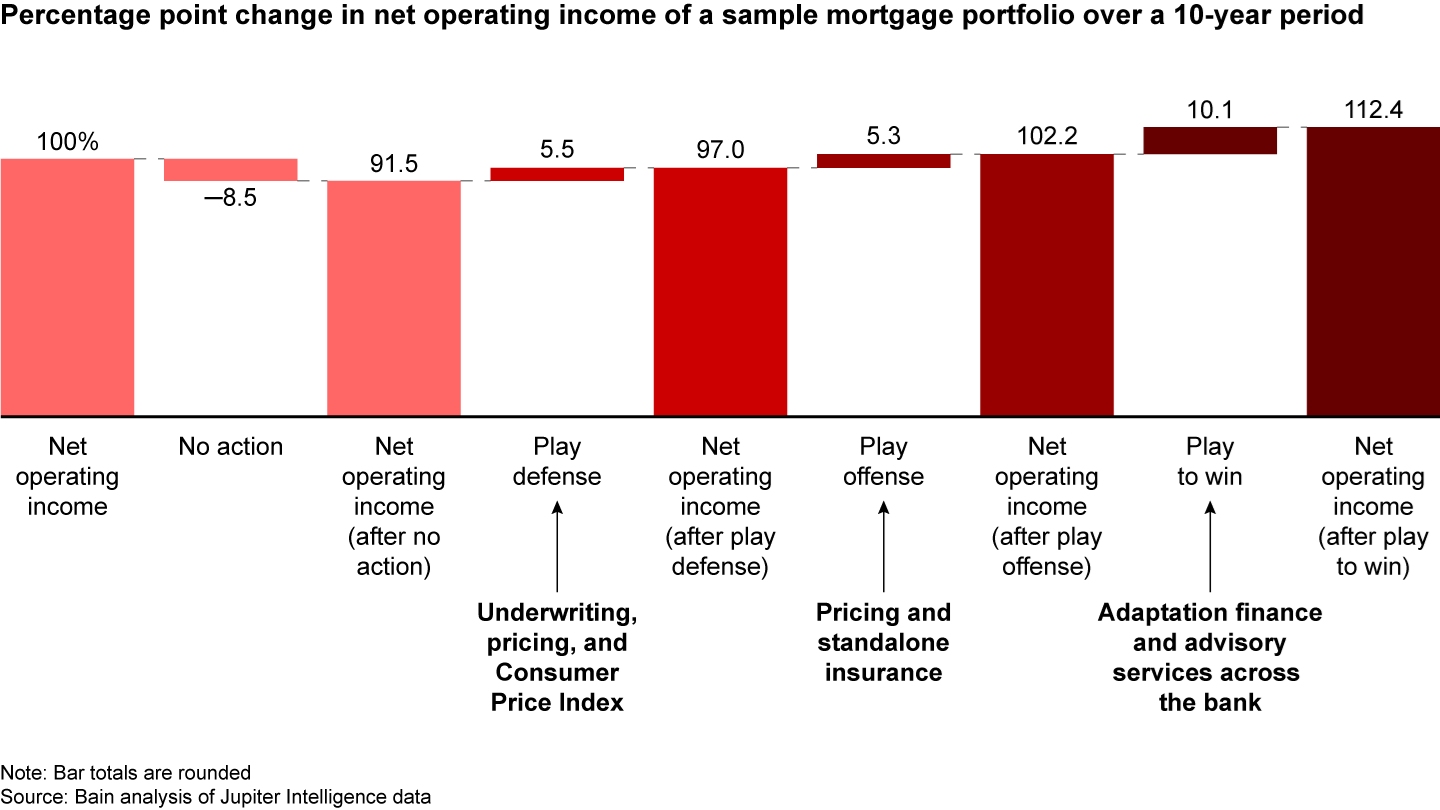
Becoming a first mover or fast follower
It’s high time for banks to integrate physical risk into risk, credit, and strategic planning processes. This entails updating credit rating assessment and policies as well as collateral analysis to reflect physical risk, adapting client onboarding to capture key risk-related information, and incorporating the risks into customer segmentation to ensure a consistent treatment of physical risk across the bank.
A shift in strategy to incorporate the realities of physical risk will require banks to continuously experiment and anticipate market responses, adapting their business model as necessary. But any tactic will have reputational and regulatory implications that need to be considered along with the economic effects.
A bank can start by assessing its portfolio to measure peril-specific exposure and identify the hot spots most relevant to the specific asset class and industry assessed. Based on the mix of perils in a portfolio, the bank can identify an initial set of mitigation tactics in line with market conditions, regulatory constraints, and the bank’s overall strategy. Depending on its ambitions, it could then also identify openings for new peril-related products and services that create value while strengthening clients and communities against climate-change effects.
Physical risk represents a major threat, to be sure, but also a unique opportunity for innovation in the banking sector. Ambitious banks that move soon to take the right steps could improve their financial stability and perception among customers and regulators. Even if a bank does not have the appetite or capabilities to be a first mover in this regard, it pays to start planning now, as it’s impossible to become a fast follower without early preparation.

About Jupiter
Jupiter is the trusted leader in climate risk analytics for organizations looking to strengthen their climate resilience. The increasing frequency and severity of extreme weather events across the globe are having a major impact on economies, businesses, and communities. With forward-focused, rigorous methodologies, and analytics delivered by some of the best scientists in the industry, Jupiter turns gold standard climate science into actionable data. Customers proactively assess the physical risks in their portfolios, address regulatory requirements and evaluate potential reputational concerns. To find out more, visit jupiterintel.com.

More On Our Partnership
Jupiter Intelligence embeds state-of-the-art climate modeling capabilities within our broader climate risk assessments.